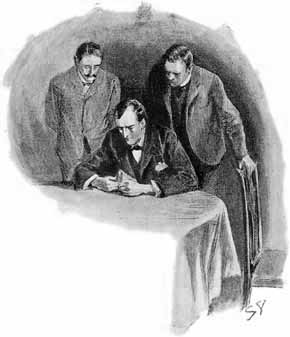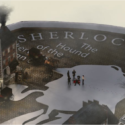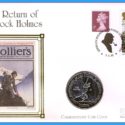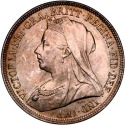A Scion Society of The Baker Street Irregulars

The 17 Steps: Black Peter
Seventeen thoughts for further ponderance of the case at hand – Black Peter (BLAC)

THE PHYSICAL CONDITION OF SHERLOCK HOLMES
Watson writes: “I have never known my friend to be in better form, both mental and physical, than in the year ’95.” Earlier, in “Empty House,” Watson had written, “there was a dead-white tinge in his aquiline face which told me that his life recently had not been a healthy one,” but was that just a part of his disguise as the old book seller? If Holmes was truly in his best physical form ever in 1895, might that have been somewhat due to his adventures while on hiatus? Or was his improved physical shape entirely the result of his routine since returning to London?
THE TEAMWORK AT 221B BAKER STREET
“The fact that several rough-looking men called during that time and inquired for Captain Basil made me understand that Holmes was working somewhere under one of the numerous disguises and names with which he concealed his own formidable identity.”
Okay, if people are coming to 221B Baker Street and asking for Captain Basil, Dr. Watson was probably not answering the door. If Holmes informed Mrs. Hudson and her staff, they could cover for “Captain Basil” if Holmes were not there. Watson doesn’t need to know, as the “rough-looking men” should never make it to the sitting room, right? One’s wife would never let one get away with such an omission, but these are two male friends, so it’s okay, isn’t it? Would you fellows out there okay with such a situation?
THE STAGING AREAS OF SHERLOCK HOLMES
Sherlock Holmes “had at least five small refuges in different parts of London, in which he was able to change his personality.”
You’re Sherlock Holmes. You’re famous. You’re a master of disguise.
You want to set up five sanctums across London where you can walk in as Holmes and walk out as someone else to pursue an investigation. Which five neighborhoods in London do you choose for your hideouts? What sorts of places do you choose to use for such change-centers?
NOTHING LIKE A MORNING PIG-JAB
Holmes “had gone out before breakfast, and I had sat down to mine when he strode into the room, his hat upon his head and a huge barbed-headed spear tucked like an umbrella under his arm.”
What was the necessity of sticking the pig before breakfast time? Was there something about the butcher’s schedule that made early morning the time to jab? Or had Holmes been thinking about it all night and just went out as soon as he thought someone would be there?
AT WHAT POINT DOES HE BECOME A PROFESSIONAL?
“I recognized him at once as Stanley Hopkins, a young police inspector, for whose future Holmes had high hopes, while he in turn professed the admiration and respect of a pupil for the scientific methods of the famous amateur.”
If you look at the Latin roots of the word “amateur,” there is no doubt that Sherlock Holmes was an amateur, doing the thing he loved most. But the truest definition of the word is “doing a thing for love alone, not professionally,” and Holmes was as professional at criminology as anyone. How can someone be a professional and an amateur at something simultaneously?
WHEN IS A CABIN NOT A CABIN?
“He had built himself a wooden outhouse–he always called it the ‘cabin’–a few hundred yards from his house, and it was here that he slept every night. It was a little, single-roomed hut, sixteen feet by ten.”
Why would a little wooden shack of the dimensions above not qualify as a cabin? Is this statement by Holmes a good argument against him having American roots, as he seems to think it odd that Carey would refer to his cabin as a cabin? Or is this just a coincidence that a former sea captain thought of a backyard cabin as a ship’s cabin and called it the “cabin,” which it was anyway?
HIS LIFE, HIS LOVER, HIS LADY, WAS THE SEA
“He had called it a cabin, and a cabin it was, sure enough, for you would have thought that you were in a ship. There was a bunk at one end, a sea-chest, maps and charts, a picture of the Sea Unicorn, a line of logbooks on a shelf, all exactly as one would expect to find it in a captain’s room.”
Black Peter Carey was obviously a guy who was deeply into the nautical life, creating his own reproduction ship’s cabin behind his house and living in it as much as possible. So why did he give up the seafaring life? If he came into a little money, wouldn’t he have wanted to get his own little boat and go travelling, rather than build a fake boat in the backyard?
MAYBE ANSTRUTHER CAN PLAY POOL WITH THURSTON
“Watson, if you can spare the time, I should be very glad of your company,” Holmes tells his friend after Inspector Hopkins explains the case.
Spare the time? What was Watson doing in 1895 besides working with Holmes? His practice had been sold a few months after Holmes’s return in 1894. Might there have been a touch of sarcasm in his words?
SHERLOCK VERSUS THE BIRDS
“My good Hopkins, I have investigated many crimes, but I have never yet seen one which was committed by a flying creature.”
Does this rule out deadly trained cormorants attacking politicians from lighthouses? Does it suggest that Wilson’s canaries were not carrying plague? Should pasticheurs take the hint and not used trained falcons, owls, or condors in their works, or was Holmes not necessarily including birds in that statement?
AND NOW, AN EXPERIMENT YOU CAN DO AT HOME
Take a nice clean drinking glass. If you’re of drinking age, or have parental supervision, pour some rum in that glass. Slosh it around a little bit, then pour it out in the nearest rum-accepting receptacle, human or otherwise. Now look at this passage:
“The fact that the crime was committed at two in the morning, and yet Peter Carey was fully dressed, suggested that he had an appointment with the murderer, which is borne out by the fact that a bottle of rum and two dirty glasses stood upon the table.”
Does rum make glasses look dirty? The Captain Morgan’s rum I used left no obvious traces, unless one smelled the glass. Did rum have sediment and foreign particles in it in the old days? Were Peter and his guest just filthy handed and greasey-lipped? And later, Holmes asks: “Is he the man who hobnobbed in rum and water with Black Peter in the dead of the night?” When did the water show up?
AND FOR DINNER — ROOTS AND BERRIES!
“Let us walk in these beautiful woods, Watson, and give a few hours to the birds and the flowers. We shall meet you here later, Hopkins . . . It was past eleven o’clock when we formed our little ambuscade.”
Holmes, Watson and Hopkins spend two hours in Carey’s cabin. Holmes and Watson then spend a few hours in the woods.
Eventually, it’s eleven o’clock. Did Holmes and Watson risk getting lost in the widespread woods? How remote or built-up was this area? Did Watson get his supper?
THE SCHEME OF HONEST NELIGAN SENIOR
“It has always been said that my father stole all the securities and fled. It is not true. It was his belief that if he were given time in which to realize them, all would be well and every creditor paid in full. He started in his little yacht for Norway just before the warrant was issued for his arrest. I can remember that last night, when he bade farewell to my mother. He left us a list of the securities he was taking, and he swore that he would come back with his honour cleared, and that none who had trusted him would suffer.”
Suppose for a moment that John Hopley Neligan’s trust in his father is justified. How was the older Neligan going to turn those securities into enough money to pay the creditors when they apparently weren’t of the value to do so at the time he fled? Was there any way his story could be true?
THE BONDS OF SEAFARING MEN
Would the two harpooners waiting in the next room during Holmes’s interview with Patick Cairns come to investigate when they heard the third harpooner being shanghaied? Wouldn’t they have also been likely to enter the fracas on Cairns side?
THE WATSON WE NEVER SEE
“Only when I pressed the cold muzzle of the revolver to his temple did he at last understand that resistance was vain.”
As usual, Watson is leaving off his own part of the conversation, unless we are to believe the doctor mutely pressed the gun to Cairns head. And pressing a gun to an enraged man’s head is only useful if you can get his attention and convince him you mean to use it. Was there a hard-boiled side to Holmes’s gun-toting friend Watson that he covered up in his writing? (Perhaps hoping to impress more ladies with his gentle literary nature?)
THE RETURN OF THE NELIGAN SECURITIES
“The tin box must be returned to him, but, of course, the securities which Peter Carey has sold are lost forever.”
Were the securities the rightful possession of young Neligan? What of all his father’s creditors?
THE TEMPTATIONS OF EXPLORATION
“Therefore spent some days in the East End, devised an Arctic expedition, put forth tempting terms for harpooners who would serve under Captain Basil …”
Why would a harpooner find a berth on an Artic exploring ship particularly tempting? Wouldn’t it be among the more dangerous ships to be on?
THE NORWEGIAN CONNECTION
Has anyone in the history of Sherlockiana come up with a plausible reason why Holmes and Watson were headed for Norway, just after hearing of John Hopley Neligan’s father heading for Norway with his securities? Did Holmes learn some secret reason the elder Neligan was headed there in hope of profit, and decide to follow that lead himself?
The Seventeen Steps originally appeared on the Hounds of the Internet e-list from September 2000 to October 2001 and later on the Sherlock Peoria blog.
 Brad Keefauver, the 41st Garrideb, is the author of The Elementary Methods of Sherlock Holmes, Sherlock and the Ladies, and The Armchair Baskerville Tour. Former publisher of The Holmes & Watson Report, The Dangling Prussian, and a whole lot of obscure, collectable little things on our boy Sherlock. Keefauver is a member of the Baker Street Irregulars and the Adventuresses of Sherlock Holmes.
Brad Keefauver, the 41st Garrideb, is the author of The Elementary Methods of Sherlock Holmes, Sherlock and the Ladies, and The Armchair Baskerville Tour. Former publisher of The Holmes & Watson Report, The Dangling Prussian, and a whole lot of obscure, collectable little things on our boy Sherlock. Keefauver is a member of the Baker Street Irregulars and the Adventuresses of Sherlock Holmes.




